On the morning of August 9th, 1945, a B-29 bomber left the island of Tinian intending to drop an atomic bomb on the city of Kokura, the location of one of the largest arsenals still standing in Japan. On arriving at the target, the plane found it obscured by clouds. It turned south and went to its secondary target: Nagasaki.
Supposedly, some in Japan still refer to the “luck of Kokura” in reference to this time in which some bad weather saved the lives of tens of thousands of people there. But what really happened that morning? Was it bad weather, or something else, that obscured, and thus saved, Kokura?
Surprisingly, there are actually a few different theories floating around, and the uncertainty over the matter is generally not realized or acknowledged.
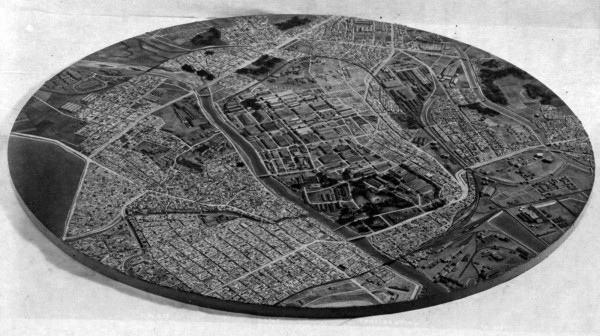
Model of the Kokura arsenal made for targeting purposes, ca. 1945. North is in the lower-right hand corner. Source: USAAF photos, via Fold3.com.
But first, let’s review the basics of the mission. The Kokura/Nagasaki mission (dubbed CENTERBOARD II), as with the Hiroshima mission before it (CENTERBOARD I), did not involve the bomber flying on its lonesome to the target, as is sometimes imagined. There were a total of six planes involved in the mission, all B-29 bombers. One of them was the strike plane that carried the Fat Man implosion bomb (Bockscar). 1 Two other planes (The Great Artiste and Big Stink) were instrument and observation planes. One other plane was a “standby” plane (Full House) that was to serve as backup if the three bombing planes ran into air resistance — because they didn’t, it instead flew back to Iwo Jima instead of on to the target after a rendezvous with the bombing plane. Lastly, there were two weather planes that flew out in advance, one to Nagasaki (the Laggin’ Dragon), the other to Kokura (the Enola Gay, the same plane that had dropped the atomic bomb on Hiroshima a few days earlier, but with a different crew). The weather planes would check out bombing conditions and then circle back, helping the bomber plane determine whether the primary or secondary target would be used. Niigata, a third atomic bombing target, was not considered on this mission because of its great geographical distance from Kokura and Nagasaki.
Bockscar was being piloted by Major Charles Sweeney. It had taken off from the island of Tinian at 3:47am, Tinian time. They had arrived at a rendezvous point at Yakushima Island around 9:15am. It rendezvoused with one of the other B-29s (the instrument plane), but did not spot the other one (the photo plane). At 9:50am, the pilot of Bockscar, Charles Sweeney, gave up and continued on to Kokura, having waited some 30 minutes longer than he was supposed to. At 10:44am, they arrived at Kokura. The flight log records that “Target was obscured by heavy ground haze and smoke.” A crew member of Bockscar rated it as “7/10 clouds coverage – Bomb must be dropped visually but I don’t think our chances are very good.” 2
Three bombing runs on Kokura were attempted, but “at no time was the aiming point seen,” as the flight log recorded. Visual bombing had been made a mandatory requirement (they did not trust the accuracy of radar-assisted bombing), so this made Kokura a failed mission. Since Bockscar had limited fuel, Sweeney decided to continue on to the secondary target, Nagasaki. They arrived at Nagasaki at 11:50am, which they also found obscured by smoke and clouds, to the degree that they made the target approach entirely by radar. Right at the last possible moment, the clouds parted just enough for the bombardier to site the target and drop the bomb. (It missed the intended target by a significant margin.) Bockscar circled the target once and then, at 12:05pm, took off for Okinawa, and from there, after refueling, Tinian.
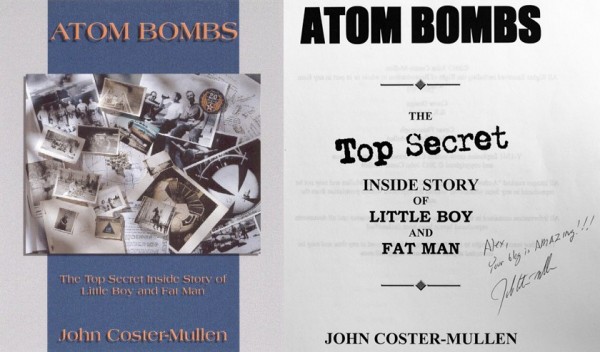
Care about the details of the Hiroshima and Nagasaki bombings? Get John’s book. I’m not just saying that because he says nice things about my blog, either.
An aside: For anyone interested in the nitty-gritty details of the Hiroshima and Nagasaki missions, my go-to reference these days is John Coster-Mullen’s Atom Bombs: The Top Secret Insider Story of Little Boy and Fat Man. I first got a copy of John’s book in 2006 or so. John sent me a new copy a few months ago, and I have been impressed with how much new material he has added over the last 8 years. (And I have managed to find a few useful things for him over the years, which have made it into his book as well — duly credited!) If you’re interested in the history of the Manhattan Project, you can’t not have a copy of John’s book… and if your copy is over 5 years old, considered getting an updated edition! All of these little details about times and planes and whatnot come from John’s book.
So what caused the “heavy ground haze and smoke”?
Theory #1: Bad weather
The most common explanation for the obscuring of Kokura is one of weather. It seems to me to be a valid possibility, but let’s pick it apart a bit.
As noted, the Enola Gay had flown ahead to Kokura to scope out the visual conditions. They had radioed back that the visibility was “3/10 low clouds, no intermediate or high clouds, and forecast of improving conditions.” 3 That was a favorable-enough weather report that Kokura, the primary target, was chosen as the first run. Upon arriving, however, Bockscar found the weather conditions were now 7/10 — too obscured to bomb. Is this plausible?
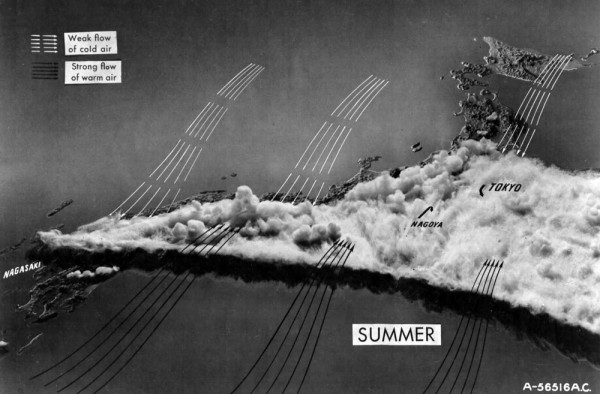
Summer weather patterns in Japan, map made in early 1945. Not great for bombing. Source: Produced for the USAAF’s IMPACT magazine, high-res version via Fold3.com. There is another wonderful map for winter weather as well.
General Groves, in his 1964 memoir, suggests that it might have been the case that the change in weather conditions was simply a matter of how much time had passed between the forecast and arrival of Bockscar. The strike plane was, as noted, delayed by around half an hour. Groves also implies that there may have been a difference between how visual the target was at an angle — how a bombardier sees it — and how it looks from straight above — how a weather plane sees it). He concludes that the reasons for the haze were “never determined.” 4
On the face of it, it’s hard to know whether such a rapid change in visibility is possible through entirely natural causes. In some parts of the world, the weather can be very volatile. Japan is one of these parts of the world, especially around the late fall. The variability of Japanese weather conditions was something that the US Army Air Forces knew very well, and was one of the bane of their bombing plans. It was a major issue in the atomic bombing discussions as well since very early on. At the first Target Committee meeting in April 1945, weather was a major point of discussion:
…it was pointed out that the months in which the initial mission will be run constitute the worst weather months of Japan. […] Dennison pointed out that all weather maps indicated that there were only an average of 6 good bombing days in August and that of those 6 days a conservative estimate would probably result in safely predicting that we would have 3 good days in the month of August but these 3 good days could not be positively predicted in advance of more than 48 hours.
Elsewhere in the memo it remarks that “3/10ths or less” cloud coverage was considered acceptable for visual bombing. It also notes that “only once in 6 years have there ever been 2 successive good visual bombing days of Tokyo,” which gives some indication of the weather’s variability.
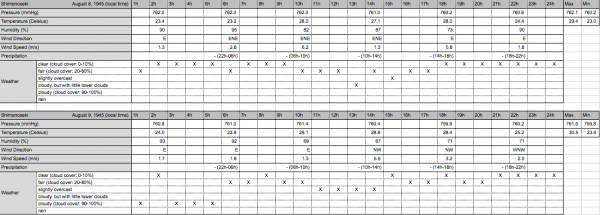
Weather from the nearby city of Shimonoseki for August 8-9, 1945. Click to enlarge, or click here for the Excel file. Source: Courtesy of the Japanese Meteorological Agency.
So it doesn’t seem impossible that it could have just been according to the weather, though the big difference between the conditions reported by the weather plane and the observed conditions by the strike plane seem, on the face of it, beyond what a half hour’s delay would accomplish. One question I don’t have the answer for is when the weather plane radioed those conditions back. In the case of the Hiroshima run, the weather plane was only 30 minutes earlier than the strike plane. If we assume that was a similar attempt on the second mission, it would mean that the strike plane was reaching the target over an hour after the weather plane had seen it, which could be a significant-enough delay for a serious change in visibility. (And another possibility is that the weather plane could have been, for whatever reason, incorrect — either at the wrong place or had its message garbled.)
There aren’t good weather records from this period, at least none I have seen. The closest site for state weather recording was in Shimonoseki, some 7 miles / 11 km northeast of Kokura. I asked the Japan Meteorological Agency for any records they had from that period and they sent me the above data. 5 It is not especially helpful towards answering this question that I can see, but I’m not a meteorologist in the slightest. For me, the big take-away from the data is that it could go from totally clear to totally obscured over the course of an hour, which at least supports the plausibility of the weather theory.
Theory #2: Smoke from firebombing
One of the other causes put forward is that the “smoke and haze” seen over Kokura was actually a result of nearby firebombing. On August 8th, 1945, the 20th AF had sent 221 B-29s to the nearby city of Yahata (Yawata) to drop incendiary bombs. 6 Yahata had been bombed several times during the war. It was, in fact, the site of the first B-29 attack on the Japanese homeland in June 1944, and indeed the first bombing attack against the Japanese homeland at all since the Doolittle raid. It had been bombed again in August 1944. The USAAF considered Yahata to be the largest steel producing center in the country, and dubbed it “the Pittsburgh of Japan.” It was the last Japanese city to be hit by a massive B-29 raid, a “night burn job” as a USAAF writer put it, and it was considered “leftover business” that had been scheduled to take place much earlier but delayed because of bad weather. 7
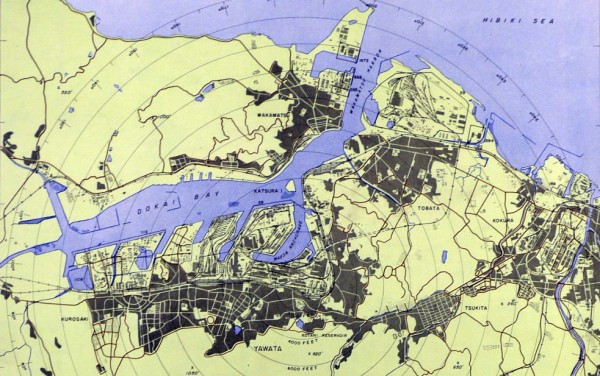
Yahata/Yawata target map, March 1945. Kokura arsenal is visible to the east. Source: JapanAirRaids.org. Click here for the uncropped, unadjusted version.
The weather at Yahata had been 4/10 clouds over the target, but this didn’t matter for B-29 firebombing raids, because accuracy was not as big a concern as with the atomic bombs. The planes had arrived at Yahata around noontime. I’ve found very little in terms of documentation about how much of Yahata was burned out with this raid — perhaps because it was so late in the war, many of the traditional sources for information about incendiary bombing results (especially those contained on the invaluable website JapanAirRaids.org) essentially omit any discussion of this final big raid.
Could the bombing of Yahata have been the cause of the smoke that obscured Kokura? It doesn’t seem impossible, but it seems to me to be somewhat unlikely.
Bockscar was flying over Kokura just a little under 24 hours after the Yahata raid began. Incendiary raids did produce extreme amounts of smoke cover, as other photographic evidence indicates clearly. Yahata was only around 6 miles / 9 km west of Kokura (and their proximity is emphasized by the fact that both are today just considered wards of a larger city, Kitakyushu).
It seems odd that the Yahata smoke would have caught them off-guard. Wouldn’t the weather plane have noticed that there was smoke over Yahata rolling towards Kokura, or at least threatening it? Yahata is close enough that at the 30,000 feet or so that a weather plane would be flying over Kokura, all they would have to do is glance in its direction to see if there was heavy cloud cover. (One can easily replicate this experience with Google Earth if one chooses.) Could the smoke cloud have been lagged behind by just the amount of time that the weather plane wouldn’t see it, then rush ahead to obscure Kokura an hour later? Could the smoke have gone from non-obscuring to obscuring in just an hour? At the wind speeds measured at Shimonoseki (around 2-12 mph), it doesn’t strike me as super likely, but I’m not an expert in this kind of thing.
Theory #3: Japanese smokescreen
One last, more obscure theory. I first read of this in John Coster-Mullen’s book. I will quote him here:
When [Bockscar] finally arrived at 10:44 AM, smoke and industrial haze had obscured Kokura. Yahata had been firebombed by over 200 of LeMay’s B-29’s the previous day and the smoke had drifted over nearby Kokura. There was also a POW camp right next door to the main downtown power plan. An American prisoner in this camp reported later the Japanese had installed a large pipe that went from the power plant down to the river. He stated that whenever B-29’s were sighted over Kokura, the steam in the plant was diverted through this pipe and into the river. This created enormous condensation clouds that also helped to obscure the city.
John himself seems to have interviewed the POW camp survivor in question, and notes in a footnote that he thinks this was the first time this claim had surfaced in print. I certainly hadn’t seen it anywhere prior to John’s book. John asked Commander Ashworth about this in 1995, and Ashworth replied that this seemed possible, and added “if the Japanese really did that, then they were damn clever!”
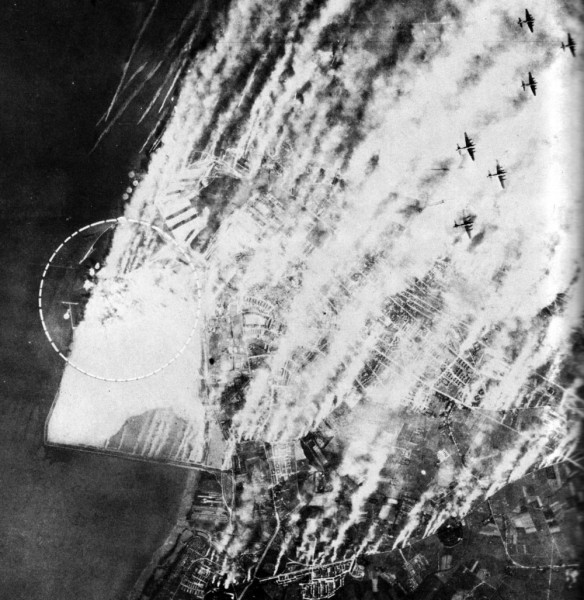
German smokescreen use at Wilhelmshaven in June 1943. Caption: “Despite a smoke screen, 168 B-17s of the Eighth Air Force attacked Wilhelmshaven on 11 June. There are three lines of generators to windward of the area covered when the wind is in the north, as it was in this case. Generator boats are at the upper left. Despite the extent of the smoke screen hits are observed inside the circle…” Source: USAAAF IMPACT magazine, vol. 1, No. 5, August 1943, page 18.
A few weeks ago, there was a story carried by Japanese newspapers along these lines:
As the 69th anniversary of the Nagasaki atomic bombing approaches, a former mill worker in the present-day city of Kitakyushu, Fukuoka Prefecture, spoke about his untold story on how he burned coal tar to block the view of U.S. aircraft as they were about to drop the A-bomb on the city. … Of the three workers, Oita resident Satoru Miyashiro, 85, who worked at a can factory in the steel mill at around the end of the war said he burned coal tar to lay a smoke screen on Aug. 9, 1945. … Miyashiro said about two days before the Nagasaki attack Yawata steel workers learned that Hiroshima had been wiped out by the “new bomb” from their colleagues who had come back to Yawata via Hiroshima. He thought the next target would be his city as there were arms factories located in the area.
Note that this isn’t quite the same thing — this is someone in Yahata who was burning coal tar after hearing an air raid drill, and the smoke going downwind (east) to Kokura. I find it a little odd that the worker in question doesn’t mention that Yahata itself was firebombed less than a day before he decided to do this.
Are either of these theories plausible? In terms of, could they have done these things — of course. Turning on an incinerator is not an implausible action, and neither is the steam cloud scenario.
But would this have reduced the visibility over Kokura from 3/10 to 7/10 in the time it took the strike plane to get there? I’m not an atmospheric scientist, so I wouldn’t want to hazard a strong position on this. One can presumably model both of these scenarios and see if either were possible. I would be extremely interested if anyone wanted to that!
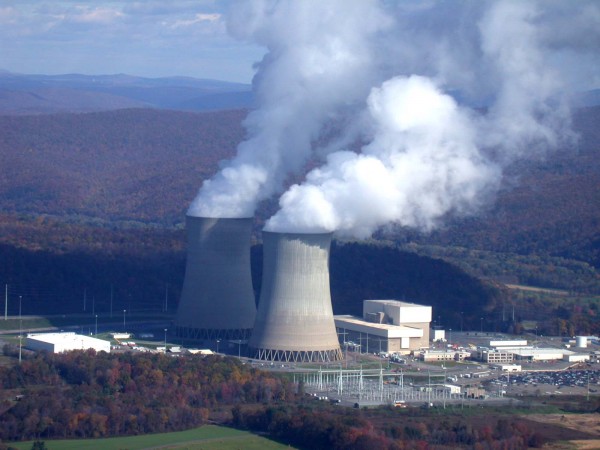
Susquehanna Steam Electric Station — just an example of what a very large nuclear power plant can generate in terms of steam. It’s a lot of steam. Could it obscure a city downwind of it from a B-29 bomber? Image source.
My gut thought is that they were not super likely to be wholly responsible for the cloud cover. If it had been steam from a single plant, I suspect someone on Bockscar would have noted it as such. We have lots of experience with steam-generating power plants — think of the clouds created by nuclear cooling towers. They certainly can put out a lot of steam. Would it be enough to block off the entire city? I’m kind of dubious.
What about the coal tar possibility? I’m especially dubious that this would have been enough. Setting up honest-to-god smokescreen for an entire city is hard work, even if you are a professional. When the Germans wanted to protect individual places (like plants) from bombers they set up dozens to hundreds of smoke pots to do the job, or used multiple dedicated smoke generators. Some of the larger smokescreen images I have found clearly involve lots of smoke sources placed at good intervals upwind of the target they are meant to protect. So I don’t know.
On the other hand, if the smoke from Yahata was not from the firebombing but instead something deliberate, it would explain the time delay issue. If the wind was going due east at around 5 mph, that would in fact be perfect for putting a smoke cover over Kokura. So it has its merits as a theory.
Conclusion
There are narrative aspects of each theory that appeal, and each of them change what is meant by the “luck of Kokura.” If bad weather is what saved Kokura, then it becomes a metaphor for how serendipitously life and death are dealt out by the hands of fate. If it was smoke from the firebombing of Yahata, then it becomes an ironic story about the Army Air Forces’ zeal for destruction could become counterproductive. If it was the result of deliberate action on behalf of the Japanese, then it becomes something much more complicated, a story about how individual action may have led to the saving of some lives… and the dooming of others. It also would change the standard story of how defenseless the Japanese were against these weapons.
Looking at these three options, I find the weather theory the easiest one to stomach. Japanese weather patterns were notoriously hard to predict and it was known as the worst season for bombing conditions. That they could change over an hour seems unsurprising to me, especially for a coastal city, where clouds can come and go which impressive rapidity (as someone who has lived in the Berkeley, Boston, and New York areas can attest). I like the irony of the Yahata story, but there are things that just don’t add up — I don’t see why the weather plane would not have mentioned it, and it seems implausible to me that it would take almost exactly 24 hours for the heavy cloud cover to have migrated a mere 5-10 miles. And for reasons indicated, I’m not sure I buy the smokescreen story — it would have been really difficult to pull off that degree of cloud cover reliably. It would have taken tremendous foresight and luck. And it is strange that this story would be “buried” for so long. This doesn’t mean that someone didn’t try it (I am emphatically not calling anyone a liar!). It just means that I’m not sure it would have worked even if they did try it.
A separate possibility is “all of the above.” Maybe the weather was bad. Maybe there was haze from the Yahata bombing. Maybe someone did try to release steam or smokescreen. Maybe all of these things occurred at once, making “the luck of Kokura” something that was the result of multiple causes. That would make Kokura extra lucky, I suppose, and not fit into any of the above pat narratives. And make Nagasaki extra un-lucky in turn.
In the end, it doesn’t really matter which of these things happened. The bare fact is that Kokura didn’t get bombed and Nagasaki did. But I find looking into these kinds of questions useful as a historian. Too often it is easy to take for granted that the explanations given in narrative works of history are “settled,” when really they are often resting on very thin evidence, thinner perhaps than the historian who writes them realizes. I don’t think we really know what happened at Kokura, and I’m not sure we ever truly will.
- Sometimes you see it as “Bock’s Car,” but it said “Bockscar” on the side of the B-29. This is one of those places where I say, “who cares?” but purists are concerned with this kind of detail.[↩]
- Flight diary of Lt. Fred Olivi, quoted in Coster-Mullen’s book.[↩]
- Bockscar flight log by Commander Frederick Ashworth, included in Norman F. Ramsey, “History of Project A,” (27 September 1945). A full of copy of Ramsey’s report is included in Coster-Mullen’s Atom Bombs book.[↩]
- Leslie Groves, Now it Can Be Told, 345: “At Kokura, they found that visual bombing was not possible, although the weather plane had reported that it should be. Whether this unexpected condition was due to the time lag, or to the difference between an observer looking straight down and a bombardier looking at the target on a slant, was never determined.”[↩]
- Here is the original Excel file they sent me.[↩]
- Most US sources list the city as “Yawata,” but it apparently corresponds with what is today transliterated as the city of Yahata, in Fukoka prefecture, and there is an entirely different city known as Yawata in Kyoto Prefecture. The kanji is the same. Yahata has since been absorbed by Kitakyushu, along with Kokura.[↩]
- Tom Prideaux, “Mission to Yawata, 7 Aug. 1945,” IMPACT, vol. 3, no. 9 (September-October 1945), 53.[↩]
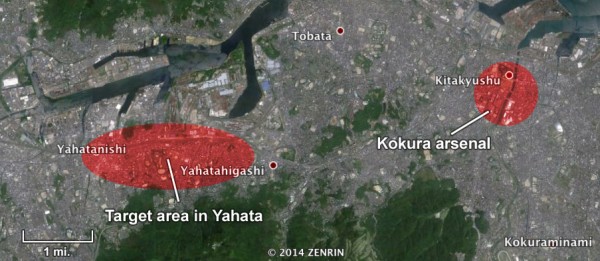
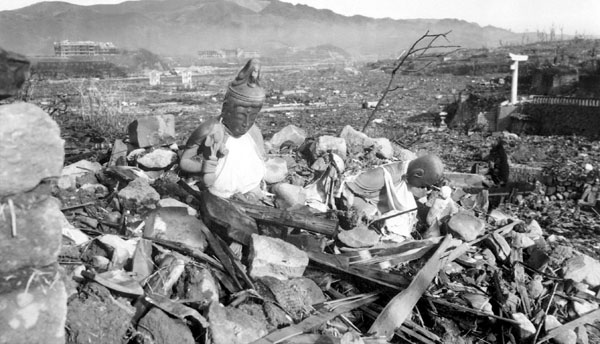


Meteorological organizations record wind direction as the direction the wind is coming *from*. You might want to contact your source and ask if they recorded it differently.
What color smoke does coal tar produce? If it burns like other petroleum products it should make black smoke.
It matches quite well, if consider all details together. 3/10 cloudcover hour before, haze from firebombing plus more black smoke from chimney tar would add up that 7/10 coverage.
From what I found, the SSE to NNW (and vice-versa) prevailing wind don’t seem to support artificial smoke, but a moisture bank moving onshore, off of the warm Japan Sea, possibly could:
http://www.slideshare.net/reservoirgeogs/japan-climate-presentation
Burning coal, wood, and charcoal for household and industrial uses may have added to the ‘ground haze and smoke’. Combine with changing weather and inexperienced aircrews (509th Composite Group combat crews only had 6 or so missions over Japan) and you could get problems with the strike.
COngrats on such a clear account of the conflicted mission story. Ashworh told me he thought Kokura smoke was from an earlier bombing run, for what that might be worth.
Alex,
Just as an aside on the steam theory, the steam output of a power plant will be several orders of magnitude larger than the moisture produced from the cooling towers. I worked at a power plant on the Ohio and the water lost to evaporation (called make up water) was very small compared to the flow of water through the boilers. Power plants of this era often didn’t have cooling towers and simply used the river as a source of water. This would give plausibility to the plant having a throughput that could sustain steam generation for some time.
Even just with backhand calculations, a 250MW power plant at a 20% conversion rate would produce 2000 cubic meters of steam a minute. Over the course of an hour it could produce 30 acres of cloud cover. This would seem to give at least some scope to the idea of cloud generation for cover.
Alex,
From mid-October 1945 until mid-Jan 1946 I was crew aboard a little LCT which tied up most every night at the Kure Navy Base near Hiroshima.
From July 1956 until May 1958 I was stationed at Ashiya AB, some twenty miles or so from Kokura, Kyushu. For two months my wife and I lived within Kokura’s city limits — for a month in the machi and another month in Kokura’s Army base housing.
In January 1987 my wife and I spent a week visiting Nagasaki.
Consequently, I found your article absolutely fascinating.
Arne Markland